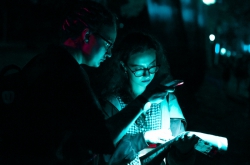All in all, 39 Light Art objects were exhibited at the festival, united by a common topic - the Laboratory of Dreams. This year, the festival was comprised of two parts: the main program that was developed by the event's organizers in collaboration with different light artists, and the light installation contest that presented 14 best works of its finalists.
"The park territory itself is wonderful and greatly contributes to imposing the festival's theme. It even seems as though this park was created for the sole purpose of dreaming. It has a castle, lakes, ponds and mazes. What is more, as everyone dreams, a dream can be common; dreams can be about just anything, so they do not limit an artist's fantasy, but act as some vector, the prism through which one can perceive any subject. During the festival, its guests could see scary dreams, dreams about love, art, and much more," shares Olga Orshanskaya, the festival's organizer.

Having organized the Street Theater festival on Elagin Island and some other major events, Olga Orshanskaya became this year’s head organizer of the Night of Light in Gatchina. According to her, the festival's jury started to review applications this March; around the same time, the contestants began to prepare their projects. Despite the fact that the festival's program was finalized two months earlier, the installations were set up just a few days before the event.
"The park is a very complex structure. Each tree, each herblet and each piece of the water's surface is important. We shouldn't clash with the space we display our projects in - it will still dominate. We have to work with regard to it, preserve it. On the other hand, there are many people visiting the park, so we have to make it so that the picture looks good and does not hinder anyone," explains Olga Orshanskaya.

What dreams were there to see at the festival? While moving along the park, the event's guests could count sheep as they once did before bedtime, listen to the Celestial Horn, feel themselves as lunatics on the Somnambulist Bridge, watch dreams about Pioneer childhood, get into the Mole Hill or on the Eros Island, and survive different nightmares.
By the way, some of these nightmares were contributed by ITMO University, which presented its FOBOS project outside of the festival's contest. FOBOS is like a water labyrinth filled with bizarre biomorphic creatures that are composed of different images that interchange and merge with each other; all of its objects are not what they seem, which makes it almost impossible to fight the feeling of imminent danger.

"We took Slavic myths about will-o-wisps and drowned corpses and created images that would remind of them. We've told the story of spirits that live in water and are then burned by fire; water, wind and fire were the elements we've focused on. Our goal was not to scare the viewers, but to remind them of the fears they've experienced as children. We always feel the fear of unknown, something that can't be named, as if you can name what you fear, the fear goes away," comments Ilya Smilga, lecturer at the Higher School of Light Design.
Some of the artists’ works gradually changed their form and even their meaning during the festival. For instance, the Dream of the Actual End of Russian Avant-Garte was a project that drew the visitors' attention throughout the night - this installation changed over the course of the performance. The artists assembled the installation over the course of the festival, and it was completed only as the festival came to its end. In the "swamp of classicism" (which was actually one of the park's ponds) they've erected a monumental figure representing modernism and progress, inside which Daniil Kharms (an early Soviet-era surrealist and absurdist poet, writer and dramatist -- Ed.) tried to stop the Boat of Modernity under the guidance of Kazimir Malevich. At the same time, several of the actors weaved the space above the pond with ropes while moving in tune with some experimental music.
 "The Dream of the Actual End of Russian Avant-Garte"
"The Dream of the Actual End of Russian Avant-Garte"
"Художник по свету в театре играет роль помощника режиссера, художник по свету в больших шоу помогает продюсеру этого шоу или артисту, который выступает на сцене. “Ночь света в Гатчине” же – это история о том, как свет становится главным инструментом и главным действующим лицом. И художник, который создает световую работу, творит не по техническому заданию, а свободно, по своей воле. Суть фестиваля – в этой свободе и в том, что свет – великая и мощная сила, которая может развиваться и создавать настроение и атмосферу," – поделилась Ольга Оршанская.

“In theaters, lighting designers work as assistant directors, during big shows they help their producers and leading actors. The Night of Light tells another story: a story in which light itself becomes both an instrument and the main character. And the artist who works with it is free from anyone’s orders, he acts of his own will. This freedom is the the festival’s main concept, light as great and wonderful power that can grow, develop, and create the mood and the atmosphere of a show,” says Olga Orshanskaya.
 Olga Orshanskaya
Olga Orshanskaya
Artist Ilya Veresk presented a story of unrequited love that made it into the contest's finals. The installation is designed in the form of gigantic hands grasping at the island. The key part of the project is an ice-cold heart in a burning hand, which only seems like ice. According to the artist, it well may not melt if this is not ice but crystal - stone will always remain stone, dead though beautiful.

Another interesting project was the Isle of Oblivion, where time stopped for its inhabitants. Only the Emperor walks silently among his court that's been frozen for hundreds of years. According to its authors' idea, he can't find rest, as he is trying to find an answer to some riddle he never solved.
The event's climax was the Dream Sonata multimedia performance on the facade of the Gatchina Palace and a fireworks display above the White Lake.

The light installations from the festival's contest were assessed by both the expert jury and via an Internet poll. The contest's winners will be announced in October at the Light Design-2017 international conference that will be organized by ITMO's Higher School of Lighting Design.





